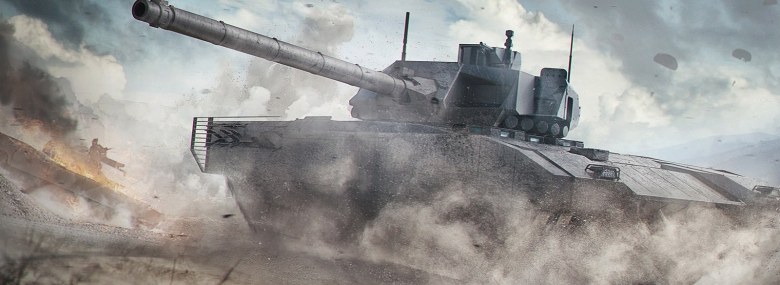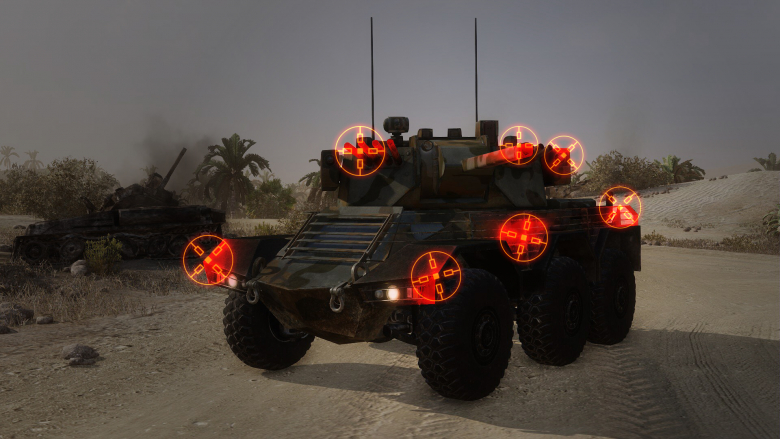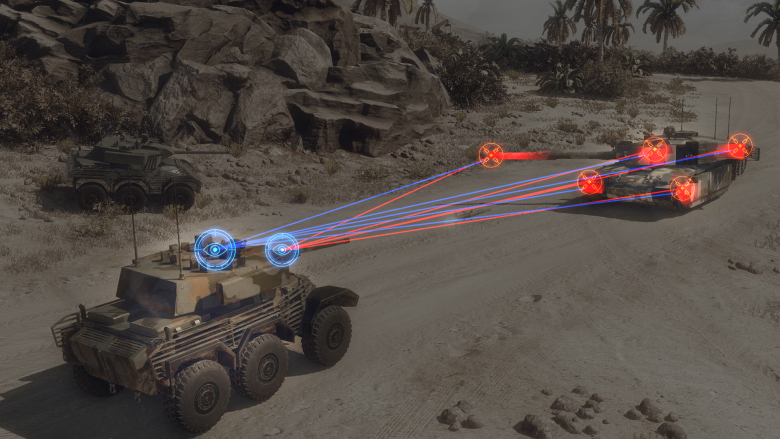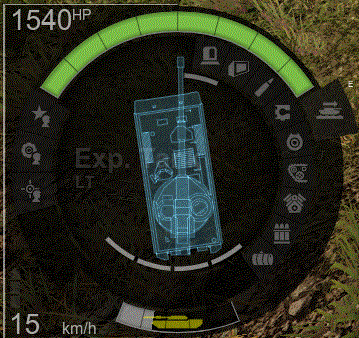
How fast will enemy vehicles appear on your screen? What if you only see half of them? What if they are hidden behind a rock or a bush? These and many other situations in Armored Warfare are controlled by the Spotting and Camouflage System.
The Spotting and Camouflage System (furthermore referred to as SCS) is one of the most important and complex systems of Armored Warfare. To make sure it’s impossible to cheat by using the infamous “wall hacks”, all the important checks and equations are calculated not by your PCs, but by our servers and a large chunk of their processing power – around 30 percent – is dedicated to these calculations.
But how exactly does it work? How does the server know what to show you?
Basic Principles
The entire SCS is operated by a management system called Spotting Manager. As the first step in every battle the Spotting Manager makes sure each vehicle in the game participates in the spotting system by assigning them a server token called Spotting Proxy. Spotting Proxies are basically representations of each vehicle’s spotting mechanism on the server side. In other words, any spotting interactions take place not between your vehicles per se, but between these Spotting Proxies purely on the server side and the SCS then only distributes the data regarding what should be rendered.
Any advanced spotting calculations for friendly vehicles are disabled – you always know where your allies are without having to rely on things like line of sight or radio distance. Even today, modern armies rely on battlefield management systems that allow them to do exactly that – keep track of every unit and every vehicle on the battlefield in order to improve situational awareness, assess tactical situations and avoid friendly fire incidents. In this sense, this Armored Warfare model is completely realistic.
Enemy vehicles, however, are a different thing entirely.
In order to determine whether you see an enemy vehicle or not, the SCS relies on spotting checks. This is how they work.
Every vehicle in the game has two “spotter” points that are used to look for the enemies. These are:
- Gun sights (the gunner looks forward to see whether he can see the enemy or not)
- Commander hatch (the commander uses the hatch to look outside)

Every vehicle also has eleven “spot check” points. These are:
- Tip of the gun barrel
- Four corners of the turret
- Four corners of the hull
- Two spots in the middle of the hull sides

SCS takes both spotter points for your vehicle and tries to trace a ray towards the enemy spot check points (in other words, 22 rays in total). If all of these rays are blocked by an obstacle (a hill, a building, a stone etc.), the spot check failed and your vehicle can’t spot the enemy. If one of the rays makes a connection from one of your spotter points to one of the enemy spot check points, the enemy vehicle becomes spotted. Naturally, this is an example for one vehicle. You may be hidden behind a wall but if an enemy creeps up behind you and sees you, you will get spotted even if no-one else has a direct line of sight towards you.

These spot checks are not permanent – to make the system manageable, these checks takes place using a certain frequency that decreases with distance. In the early iterations, spotting checks at long distances were performed roughly once per 2 seconds, the current maximum value is once per 0.8 seconds with the closest checks being considerably more frequent (the frequency of the checks was increased both in Update 0.20 and Update 0.21).
The distance the rays travel (spotting distance) is not, however, infinite. The maximum value it can theoretically have (that is equal to maximum vehicle render distance – 808 meters) is reduced by a number of factors that include:
- Vehicle View Range
- Vehicle Configuration (modules, retrofits, commander skills)
- Enemy vehicle camouflage (also depends on many factors)
- Environmental camouflage (bushes and other foliage)
- Action (moving, firing a gun)
- Game Mode (PvE has additional special rules)
Please note, however, that the maximum currently achievable view range value is 534 meters.
Vehicle View Range
Vehicle View Range is a number (its units are meters) that represents the quality of the vehicle’s optics. Generally speaking, it somewhat increases with Tiers (as the technology improves) and ranges from simple gun sights to advanced computer-assisted thermal imager optics that allow you to spot the enemy at very long distances. A Tier 1 Light Tank spotting distance is, for example, 415 meters while a Tier 10 Light Tank spotting distance is 460 meters.
View Range is a balancing parameter that heavily depends on a class. Light Tanks and Armored Fighting Vehicles generally have the highest view range as their role is not only to deal damage, but also to spot the enemy vehicles for their allies. Tank Destroyers usually also have a good view range but Main Battle Tanks have it lower. The Self-Propelled Gun class has it the lowest in Armored Warfare.
Vehicle Configuration
Basic Vehicle View Range and spotting efficiency in general can be considerably modified by properly configuring your vehicle:
- Recon Package module, available to spotting-oriented AFVs, increases the view range when the vehicle is standing
- Thermal Sights modules decrease the effectiveness of environmental camouflage
- Some Commander Skills (like Sabrina Washington’s Vigilant skill) increase the vehicle view range
- Improved Electronic Lenses Retrofit increases the view range when the vehicle is standing
- Augmented Optics Retrofit increases the view range under all circumstances but not by as much
Please note that a properly configured AFV or LT will in vast majority of cases have a better view range value than a MBT. This arrangement makes each unique. Small AFVs such as the CRAB are the best scouts in the game.
Enemy Vehicle Camouflage
Vehicle Camouflage is, in a way, the polar opposite of View Range. It’s a modifier that reduces the enemy vehicle’s view range by a certain amount, specifically a percentage value. In Armored Warfare, this is determined by the vehicle’s camouflage factor.
The camouflage factor uses percentage format. Until 0.21, the camouflage factor was determined by a fraction (0.370 for VBL INGWE for example) but we decided to switch to the more comprehensive percentage formatting. As such, 37 percent camouflage factor (earlier 0.37) will reduce the enemy view range by 37 percent. In other words, if the enemy vehicle would be normally able to spot targets at 400 meters (400m view range), it would only be able to spot the VBL INGWE at 252 meters since the number 400 was reduced by 37 percent.
Like View Range, Camouflage Factor too depends on vehicle class (AFVs are the stealthiest while MBTs and SPGs are usually the most conspicuous vehicles on the battlefield), Tier and size. Smaller (or lower, height plays a major role) vehicles will have better camouflage factor than large, hulking ones. Additionally, vehicle’s camouflage factor can be modified by:
- Commander skills (for example, Juan Carlos Miramon’s Blend In improves camouflage factor)
- Modules (Electrical Starter and Generator increases camouflage factor on the move)
- Retrofits (Electro-Absorbing Paint increases camouflage factor when the vehicle is stopped)
- Visual Camouflage (increases the camouflage factor by 0.05 – or 5 percent)
- AFV Active Ability (decreases targeted vehicle’s camouflage factor)
Please note that no matter what, your camouflage rating cannot drop below 0 – in other words, you will never allow the enemies to see you beyond the spotting ranges determined by their vehicles.
Environmental Camouflage
As it is in real life, foliage such as bushes or small trees makes vehicles harder to spot. In Armored Warfare, hiding behind a bush (so that its outline conceals all your vehicle’s spot check points relatively to the enemy spotter) gives you a major bonus to your camouflage factor – it improves by 30% (0.3 in camouflage factor terms). In other words, the rays between enemy spotter points and your spot check points have to pass through the bush objects. This is called Environmental Camouflage Bonus. Please note that the camouflage bonus is not unified (bushes with fewer leaves for example provide smaller bonuses, as common sense dictates).

Multiple environmental camouflage bonuses (for multiple bushes that are between you and a spotter) can stack up to the bonus value of 0.45 (45 percent). In other words, even a Main Battle Tank with very low camouflage value of 0.1 (10 percent) can become significantly harder to detect when hiding behind bushes.
Tree canopies work much like bushes but only the part with leaves is taken into account. When you stand under a tall tree with a large crown, it will not help your camouflage in the slightest. But if you stand on the same level as the tree canopy so that it is positioned between you and the enemy, it will work much like a bush. Fallen trees also work like improvised bushes.
Please note:
- Foliage within 15 meters of the spotter do not count towards enemy spotter’s environmental camouflage bonus
- Your Environmental Camouflage Bonus can be reduced by firing your own weapon (bushes within 15 meters of you lose 66 percent of their environmental camouflage bonus for 5 seconds)
- Some modules such as the Thermal Imager or Commander Skills also reduce the Environmental Camouflage Bonus
- The ADAPTIV module, unique (for now) to the PL-01, acts as a “portable bush” and provides environmental camouflage bonus rather than standard camouflage bonus in all directions
Action
Moving or firing your gun makes you easier to spot. In Armored Warfare, both actions influence your camouflage factor considerably. However, as stated above, camouflage can never drop below 0.
Firing a gun not only reduces the environmental camouflage as stated above, but also your own base camouflage, making you easier to spot for 5 seconds, as such (please note that the values are average as the penalty slightly differs from vehicle to vehicle and apply to one shot with exceptions listed below them):
- Tank Destroyers (Gun and ATGM) and Armored Fighting Vehicles receive low overall penalty (10 to 15 percent per shot)
- Light Tanks and non-TD ATGM launches receive medium overall penalty per shot (20 percent)
- All other vehicles else receives high penalty (25 percent)
Vehicles that are capable of firing multiple shots in a row without longer reloads (Terminator ATGM volleys, autoloader magazines, ready racks) see the penalty increase gradually (this is actually an improvement since in the previous spotting iteration, their overall camouflage was reduced to 0 with their second shot, leading in many cases to them being instantly spotted). Currently, firing a half of your magazine (that is 3 rounds or larger, excluding for example the XM1A3 FASTDRAW) gives you roughly the same penalty as if you fired a single shot weapon and then grows, eventually bringing your camouflage to 0.
Autocannons receive a penalty of 2 percent per autocannon shot that can stack – firing continuously for 3-5 seconds will easily bring your camouflage to 0 – short bursts are now, however, relatively safe (unlike before).
Moving also reduces camouflage – please note that even traversing the hull on the spot counts as movement while traversing a turret does not. This penalty isn’t binary – when the vehicle moves, it becomes active and when moving fast, it (quickly) climbs to its maximum value for that given speed. Moving slow reduces the maximum penalty. After the vehicle stops, the penalty (again, quickly) drops to its 0 value. Light Tanks do not lose camouflage on the move and Armored Fighting Vehicles do not lose camouflage when moving slowly.
Last but not least, vehicles on fire (any type of fire) receive a major penalty to camouflage.
PvE Spotting
Spotting in PvP and Global Operations works as described above, but spotting in PvE mode has its peculiarities. First and foremost, AI does not “cheat” – the AI spotting works on the same principle as any other spotting.
Due to the fact that the PvE maps are smaller than PvP maps, the spotting range is reduced for all vehicles on the map (players and AI). The view range for all vehicles is reduced by 55 percent. This actually affects the AI opponents more since:
- Many AI opponents are AFVs
- They come from multiple angles, making them more efficient in spotting players
This penalty is applied to the final check. Furthermore, Update 0.21 introduces additional AI penalties to AI view range depending on PvE difficulty levels:
- Easy Difficulty: Camouflage reduced by 20 percent and View Range by 15 percent
- Medium Difficulty: Camouflage reduced by 15 percent and View Range by 10 percent
- Hard Difficulty: Camouflage reduced by 10 percent and View Range by 5 percent
No other changes are currently present in the PvE mode. We are evaluating Update 0.21 feedback.
Losing Spotting Check
An already spotted vehicle may disappear again from player sights if:
- It moves behind some cover and the line of sight with the spotter is broken
- It moves far enough or gains enough camouflage by other means for the spotting check to fail
Upon failed spotting check, the vehicle will still briefly (for 5 seconds) stay spotted regardless of circumstances (except for deploying a smoke screen). After that, the silhouette is removed for 1 second and finally the vehicle disappears. This mechanism prevents vehicles from “magically disappearing” in the middle of a battlefield in most cases, or at least mitigates such situations to bare minimum.
Advanced Spotting Mechanics
Any enemy vehicle inside a certain range (50 meters) is spotted automatically regardless of any other circumstances – this is to simulate the state where the vehicle is so close the crews (or anyone around them) can hear it even over the racket of their own vehicle or the troops accompanying them let them know of the threat. In game terms, this rule is here to prevent situations that could potentially result in enemy tanks appearing at point blank range, which would result in poor gameplay.
To a certain degree, the examples listed in the sections above are simplified to explain the basics of the mechanics. In reality, the calculation of the spotting range is a bit more complex. Earlier (before Update 0.20), the general equation for spotting distance was:
SpottingDistance = ViewRange*(1 - Camouflage)
However, the current spotting distance calculator is:
SpottingDistance = 50+((ViewRange-50)*(1-Camouflage))
This change in the way the automatic spotting range interacts was introduced to make sure that the standard spotting distance wouldn’t drop below 50 meters as that produced strange results. For example, 90 percent camouflage against a 400 meter view range worked earlier as such:
SpottingDistance = 400*(1-0.9) = 40 meters
While now, it works as such:
SpottingDistance = 50+((400-50)*(1-0.9)) = 85 meters
In other words, earlier, the spotting range could theoretically drop below the automatic 50 meter spotting limit, which produced undesired results where some vehicles were stealthy enough to be completely invisible save for the automatic 50 meter spotting system.
Additionally, a spotting ray can only penetrate 10 objects before it disappears. Areas with a lot of foliage are therefore exceptionally hard to scout in.
As a side note, early in Armored Warfare development (even before the alpha version), a different spotting mechanism was in place where, the Gun Sights spotter points increases the spotting distance in a narrow cone. In other words, the vehicles could see further if they “looked that way” – this mechanism was never implemented as it was found that it increased static gameplay, otherwise known as “camping”.
Additional Spotting Tools
All vehicles do have several other tools at their disposal to help the camouflage and spotting.
“Spotted” Indicator – an icon that appears on the screen whenever your vehicle is spotted. This indicator is present for all vehicle classes but while for most of them it activates only 2.5 seconds after you become spotted by someone, it is instant for the majority of the Armored Fighting Vehicle class, allowing it a bit more time to retreat to compensate for its fragility (the bonus is in fact granted by the Reckon Package module that many AFVs have).
Environmental Spotting Indicator – the indicator provides feedback for the environment in a 30 meter radius around your vehicle. Within that 30 meter radius, it uses the UI element to show the direction of the environmental cover as well as the amount of cover you get from that direction. If you are hiding behind a single bush, you are only getting a small amount of camouflage and the indicator displays a dark gray mark in that direction.

The more camouflage you get from the environment, the brighter the mark in that direction. If you are hiding behind a solid object such as a building or the side of a cliff, the indicator displays white to indicate that you are fully covered by the environment from that direction. This feature only provides feedback on the environment in your direct vicinity and does not indicate if you are going to be spotted or not. You still may be spotted by other players depending on your camouflage value, their view range, and lines of sight. Hiding next to a wall may show full cover, but if an enemy is high on a hill and can see you over the wall, you are still going to be spotted.
Designate Target – Armored Fighting Vehicles have a special ability called Designate Target. Targeting an enemy with this ability deals massive penalty to his camouflage – additionally, your allies will inflict increased damage to the designated target.
Smoke Grenade Launchers or Smoke Generators – for spotting purposes, the smoke from these devices counts as a physical obstacle (a “wall”, if you will) and will instantly break the line of sight. Any deployment of smoke grenades or smoke generator charges invokes a special spotting check outside of the spotting check cycle to ensure that the line of sight loss is instant.






